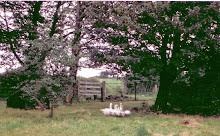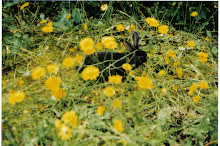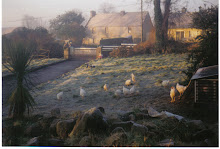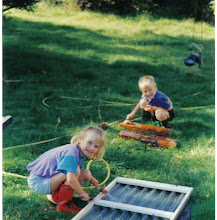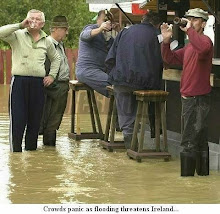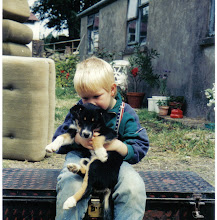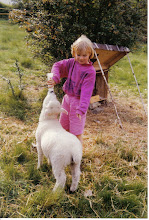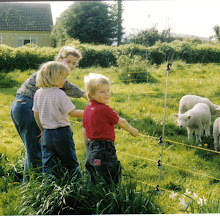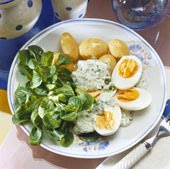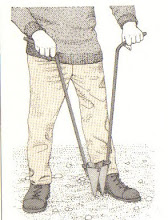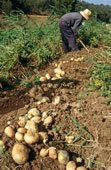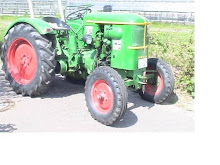We got our first little chicks (broilers, actually) that summer. I collected 24 of these cute yellow fur balls in a cardboard box from a farmer in our family car. Their chirping and pungent smell --in spite of their miniature size-- quickly filled the jeep. My kids and 2 of the neighbor's ones we had taken with us for the ride where delighted.
We had built another little hut according to Seymour's specifications. No caged chickens for us! The chicken farms in the neighborhood of my parents home in northern Germany, huge commercial enterprises with thousands of animals that never saw the light of day still make my stomach revolt. It was their stench to be specific. It lay like a smelly blanket over miles of agricultural land and one gave a sigh of relief on leaving that area. Chicken slurry smells just as bad as pig's. That beside the idea of their caged, imprisoned existence put me of eggs and chicken meat for years.
The fur balls turn their color quickly into white when they grow up and develop white feathers.
It posed an immense problem to feed them. The Creamery where we (and other farmers) bought our feeds, only had the usual starter feeds. Enhanced with all the goodies that an organic farmer objects to: grains enhanced with growth promoters to kick start them and medicines for good measure because they normally fall sick early when in confined accommodation. Antibiotics, primarily. We opted for pure maize, unadulterated with any dubious extras, barley and wheat grains all of which we had to crush by hand or an old coffee grinder to make them small enough for the only day-olds.
Every turkey or chicken that you buy that hasn't earned the label organic will have got started on the above mentioned extras. They also fed on grass and the occasional salad leaf, free to roam our garden. They thrived just fine until we slaughtered them for our own consumption when it turned too cold for them.
Our zoo now consisted of 4 lambs, 4 calves, a cat, a dog and 24 broilers as well as a dozen of pullets.
Friday, February 26, 2010
Thursday, February 18, 2010
Conventional vs Organic Meats
Our cattle, lambs, pigs and chickens were grass-fed. They lived a happy life in a natural, healthy environment until they went the way of all flesh. Before we produced our own on the farm, we had practically given up on meats unless it was organic−often hard to get hold of and more expensive.
In contrast to intensive farming, organically raised animals are not confined to tiny cages where they can’t move. They don’t have to live and grow in overcrowded, often filthy and inhumane conditions where they are treated as production units, i.e. they have to put on weight at top speed at lowest costs. They are treated as living creatures instead.
Conventional agriculture pumps animals full of hormones and drugs, feeds them unnatural diets, douses vegetables with chemical pesticides and fertilizers, and introduces genetically modified seeds into the environment. How can the food on your family’s dinner table not be harmful to your health?
Besides the health benefits of organic farming, there is also the environmental result of significantly less fuel consumption, less erosion, less air and water pollution and greater soil fertility.
I can’t eat chicken dishes anymore when eating out unless the menu states specifically grass-fed or free range. If you can’t get organic produce all the time, there is now the “all natural, no-antibiotic, no growth-hormones” raised chicken, pork and beef in some supermarkets here. I have my doubts about this concept, however. Out of my own experience in Ireland, I know that the organic farming status and organic label are hard to achieve and guarantee what they promise.
In contrast to intensive farming, organically raised animals are not confined to tiny cages where they can’t move. They don’t have to live and grow in overcrowded, often filthy and inhumane conditions where they are treated as production units, i.e. they have to put on weight at top speed at lowest costs. They are treated as living creatures instead.
Conventional agriculture pumps animals full of hormones and drugs, feeds them unnatural diets, douses vegetables with chemical pesticides and fertilizers, and introduces genetically modified seeds into the environment. How can the food on your family’s dinner table not be harmful to your health?
Besides the health benefits of organic farming, there is also the environmental result of significantly less fuel consumption, less erosion, less air and water pollution and greater soil fertility.
I can’t eat chicken dishes anymore when eating out unless the menu states specifically grass-fed or free range. If you can’t get organic produce all the time, there is now the “all natural, no-antibiotic, no growth-hormones” raised chicken, pork and beef in some supermarkets here. I have my doubts about this concept, however. Out of my own experience in Ireland, I know that the organic farming status and organic label are hard to achieve and guarantee what they promise.
Friday, February 12, 2010
Thanks for comments
I appreciate comments left. I got the translation of what a Chinese reader wrote: 要持續更新下去喲!!祝你心情愉快 "Please continue updating!! May you have joyful mood."In case anybody else was wondering what it meant...
Sunday, February 7, 2010
Bullocks
When Mac bought 4 calves, I knew he meant business. For self-sufficiency on the farm, even John Seymour said that one cow is enough. It provides you also with your dairy needs including cheese. The four were Aberdeen Angus, a Scottish breed well regarded for its meat and even temper. So down the line, there was a herd planned. Since we didn’t have a milk quota, we couldn’t just produce milk without end. One cow for our personal consumption would have been OK, but we didn’t need more than half a gallon a day for ourselves and neither Mac nor I felt like milking. We didn’t know how to either. But that we could have learned from The Book of course. A cow needs regular milking twice a day. There was a limit, however, to what Mac was willing to do and that didn’t include getting up and milking every morning, or being around late each afternoon. We saw neighbors driving their cattle home along the road each day in the morning and evening messing up the roadway in the process. This was great excitement each time for the dogs steering them; when an impatient car had to follow them patiently until they turned into their familiar yard entrance; or for the farmer’s wife, armed with a stick in wellies and headscarf when it rained. It seemed to be a woman’s job and it seemed to rain a lot. Sometimes children would follow in the back to keep the herd together. Some cows are notorious for sampling what hedgerows have to offer.
We named our new additions to the family Rira, Lulu, Micki and Roisin; two after the characters in Amy’s Irish reader and the other two after my mother and father. Micki‘s purpose in life was to provide us with beef some day. Mac finally explained his intentions that we were starting a herd of suckling cows and that we were into grass and beef — instead of dairy. The calves were already weaned and quickly outgrew our orchard. That’s why we had kept the 4 acres for initially while the rest of the farm was rented out in the first year. Mac had put his economist’s hat on while walking the land one day and a shift change from self-sufficiency to commercial agriculture had occurred by the end of that first year. Our escapist enterprise had to become a viable business.
So we had to learn more about being in the beef business. Cattle come as little bulls and little cows. Bulls must be castrated when less than two months old. For that you don’t need a vet. Elastic bands are fitted around their testicles and they shrivel away over time - some have to be cut then; mercifully, some not - and then they turn into “bullocks.” Easy as pie. Even Nicole Kidman learned to do it for her role in Australia where she plays a British aristocrat of 1930 who get a cattle station as inheritance. For full instructions see How to Castrate a Bull. It keeps bulls' temperments in check -- a wise move unless you are breeding for bulls fights. Nobody in Ireland said steer or oxen. Bullocks — not to be confused with bollocks. It often sounded the same. As did ballcocks, which caused quite a stir lately on an Irish radio show and in ongoing jokes. But that's another story.
We named our new additions to the family Rira, Lulu, Micki and Roisin; two after the characters in Amy’s Irish reader and the other two after my mother and father. Micki‘s purpose in life was to provide us with beef some day. Mac finally explained his intentions that we were starting a herd of suckling cows and that we were into grass and beef — instead of dairy. The calves were already weaned and quickly outgrew our orchard. That’s why we had kept the 4 acres for initially while the rest of the farm was rented out in the first year. Mac had put his economist’s hat on while walking the land one day and a shift change from self-sufficiency to commercial agriculture had occurred by the end of that first year. Our escapist enterprise had to become a viable business.
So we had to learn more about being in the beef business. Cattle come as little bulls and little cows. Bulls must be castrated when less than two months old. For that you don’t need a vet. Elastic bands are fitted around their testicles and they shrivel away over time - some have to be cut then; mercifully, some not - and then they turn into “bullocks.” Easy as pie. Even Nicole Kidman learned to do it for her role in Australia where she plays a British aristocrat of 1930 who get a cattle station as inheritance. For full instructions see How to Castrate a Bull. It keeps bulls' temperments in check -- a wise move unless you are breeding for bulls fights. Nobody in Ireland said steer or oxen. Bullocks — not to be confused with bollocks. It often sounded the same. As did ballcocks, which caused quite a stir lately on an Irish radio show and in ongoing jokes. But that's another story.
Subscribe to:
Posts (Atom)




























